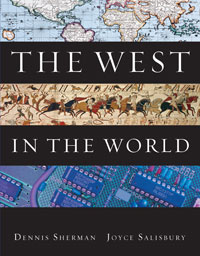 
The West in the World, 4th Edition (Sherman)Chapter 17:
Factories, Cities, and Families in the Industrial AgeCritical Thinking Questions- The Industrial Revolution Begins
- What differences between the Western and non-Western worlds may have led to the industrial revolution emerging first in the former?
- What combination of advantages allowed Britain to undergo industrialization first?
- Why did Britain have the capital necessary to invest in industry?
- How did the agricultural revolution help to bring about the industrial revolution in Britain?
- New Markets, Machines, and Power
- How were growing markets, inventors, and entrepreneurs interrelated?
- How did inventions change the way cotton and its products were manufactured? Which were the most important inventions?
- In what ways did the production of iron change?
- How did steam engines transform the way factories functioned?
- What effect did the railroads have on the Industrial Revolution as well as on the landscape?
- Industrialization Spreads to the Continent
- To which parts of the European continent did industrialization spread from Britain after 1830?
- What steps did these governments on the continent take to promote industrialization in their own countries?
- Why did countries in southern, central, and eastern Europe remain primarily agricultural and untouched by industrialization?
- Balancing Benefits and Burdens of Industrialization
- Which group gained most from Britain's newfound prosperity? How did its social situation change?
- In industrializing Britain, what was life like for ordinary people in the countryside? In the factories?
- What sorts of insecurities, risks, and lifestyle changes did factory laborers face?
- What types of organizations did workers organize throughout this period of industrialization? How effective were these organizations before 1850?
- Life in the Growing Cities
- What factors were responsible for the growth of towns and cities in Europe between 1780 and 1850?
- What kinds of environmental changes and problems accompanied urbanization?
- What kinds of social problems emerged in these expanding cities? Why?
- Public Health and Medicine in the Industrial Age
- What health risks did the new working class face?
- How did medical commentators explain the outbreaks of disease plaguing cities?
- How effective were the treatments prescribed by physicians in the early 1800s?
- How did improvements in European diets help to protect public health?
- In what ways did European doctors apply scientific methods to medicine and what improvements did these methods bring?
- Family Ideals and Realities
- As the roles within the family changed, what values did the middle class promote as the norms for proper family life?
- Describe the separate spheres of men and women and the responsibilities associated with them.
- What occupations were available to middle-class women outside of the home? Why were they limited in this manner?
- What type of "legal relationship" existed between married men and their wives and children?
- How did the lives and options of working- and middle-class women differ?
- How did industrialization place stresses upon the working-class family?
 |  |
|





